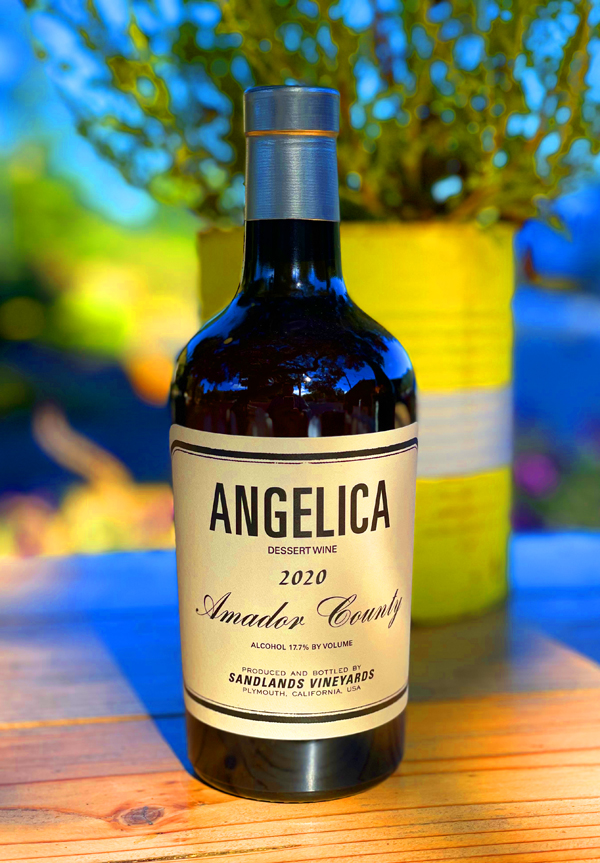2020 Sandlands Vineyards, Angelica, Mission Grape Fortified Dessert Wine, Amador County, Sierra Foothills.
I don’t drink or review dessert wines that often, but I was really excited to try this Sandlands Vineyards Angelica, which is modern take on California’s first commercial wine from the late 1700s and I was not disappointed, winemaker Tegan Passalacqua has made an awesome version. There are hints of tawny port and sherry, but with a bright freshness, making it easy to love and great with a cheese plate or Creme Brulee. Made from Amador County old vine vines, originally planted in the 1850s at Deaver Ranch, this Angelica starts with a warm sweet nutty character, honeyed citrus and molasses notes in a smooth textured wine that adds subtle spice, a delicate fruitiness and wood elements. The historic Mission grape, in this case Listan Prieto, which is also known as Pais, it is a grape that is responsible for producing California’s very first wines made from European vines, having come to California along with the Spanish Missions in the 1700s. Mission grapes are a variety of vitis vinifera in the Listan family, including Listan Prieto and Listan Negro, that was first introduced from Spain to the western coasts of North and South America by the missionaries for use in making sacramental, table, and fortified wines. It is grown in South America, particularly in Chile, where they first planted these grapes, and Peru, under then names Rosa del Peru, Criolla and Pais, as well as being found in the Canary Islands, where it has become wildly successful on the volcanic slopes there. The Mission grape, most likely Listan Prieto, was introduced by the mentioned Franciscans and it was originally believed that the first plantings were at Mission San Diego de Alcalá in 1769, and it is thought in 1783, the first wine was most likely produced from vines near the Mission San Gabriel in Los Angeles, though some believe it was first done at the Mission at San Juan Capistrano.
Angelica, unlike Port, which is fermented about halfway and then fortified with neutral (spirit) brandy, it is fermented barely or not at all, depending on the recipe of the individual winemaker. Most believe the original versions were made by picking the grapes at full ripeness, crushing the bunches with not much skin maceration, using just the fresh grape juice, then adding the brandy to heighten the alcohol level to the desired amount and also preventing any further fermentation. This light gold/caramel colored Sandlands bottling saw over a year in used oak barrel, which allowed the wine to mature and round out. The results and quality varied back in the day, but because the regular Mission Grape red wines were often barely drinkable, Angelica became more popular. My first experience with the Mission grape and Angelica, came when I tasted Gypsy Canyon Winery’s Angelica, and who accidentally discovered three acres of Mission vines that had been hidden for decades, covered by California sage and scrub brushes, that dated back to 1887 making them some of California’s oldest known Mission vines. The Mission grape wines, and especially Angelica are being recreated in tiny amounts, as there has been some renewed interest in recent years in this varietal and Tegan Passalacqua, the head winemaker at Turley Wine Cellars, is making both Mission red and Angelica under his Sandlands label. These are excellent and faithful recreations, as this small production and handcrafted 2020 Angelica shows. This wine was a great way to finish off a panel of interesting Mission grape wines, including Pax, Monte Rio, Ryan Stirm’s Los Chuchaquis Rosa del Peru and Passalacqua’s Sandlands, all of which were worth chasing down to experience this grape. As mentioned in my prior reviews, Sandlands is the personal project of Tegan and Olivia Passalacqua and the line-up consists of some rarities including some almost forgotten classic California varieties, primarily grown in sandy soils, and I highly recommend getting on their mailing list!
($65 Est. 375ml.) 94 Points, grapelive
